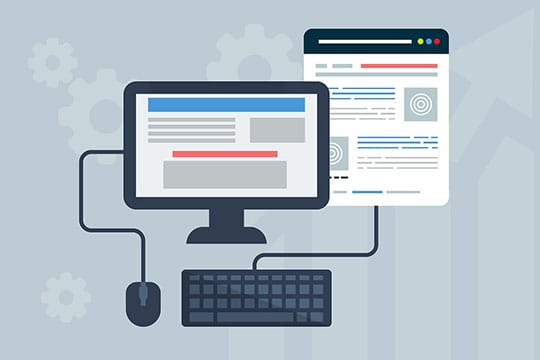Creating websites is one of the most in-demand skills in the job market. In order to be a professional web developer, you have a long path ahead of you, and it is not without troubles and obstacles. There are many web development technologies you can use to create websites, but what are the differences? Why is someone building a site using WordPress while another is using Node.js? Why would a programmer prefer to use Angular and the other would choose to use React? This article will answer your questions.
Your Roadmap for Web Development & Website Creation

First, let’s talk about the roadmap that we will follow, perhaps it makes things clearer – web development is a process consisting of many steps with many twists and turns – it starts with the idea and ending with a professional website, and the steps are as follows:
- Getting started: Learn about the basic tools.
- The first step: developing the front-end.
- The second step: taking care of the backend.
- The last step: tools and concepts for developers.
Recommended for you: Magento vs WordPress: When to Choose Which Platform in 2020?
Beginning of The Journey – Basic Tools for Web Development

You must learn about the basic tools you’ll need to develop a website.
Browser
 A web developer who specializes in website design needs a browser always, as it is used to experiment with the site during the design process. The traditional and time-tested choice is Google Chrome, as it supports the most up-to-date HTML, CSS, and ECMAScript standards. It has the tools that allow you to update and tinker with the web design in real-time.
A web developer who specializes in website design needs a browser always, as it is used to experiment with the site during the design process. The traditional and time-tested choice is Google Chrome, as it supports the most up-to-date HTML, CSS, and ECMAScript standards. It has the tools that allow you to update and tinker with the web design in real-time.
The Editor
 Web development is characterized by the ability to use any text editor to write code, from a simple notepad to the browsers themselves. However, there are some better code editors that provide many additions and improvements on top of traditional and basic editors to facilitate writing and understanding programs. Among the most famous editors: VS Code – Atom – WebStorm – all of them are powerful and convenient for web development with the most common one being VS Code.
Web development is characterized by the ability to use any text editor to write code, from a simple notepad to the browsers themselves. However, there are some better code editors that provide many additions and improvements on top of traditional and basic editors to facilitate writing and understanding programs. Among the most famous editors: VS Code – Atom – WebStorm – all of them are powerful and convenient for web development with the most common one being VS Code.
Design Program
 When designing a website, you need to create assets of different sizes, shapes, and colors, and you often need to heavily edit public domain images if you want to make your website look unique and attractive. That’s why you’ll need to use a design program. If you are on a low budget and want a free choice, it is best to go with GIMP. Most professionals, however, still use Photoshop due to its robust feature set.
When designing a website, you need to create assets of different sizes, shapes, and colors, and you often need to heavily edit public domain images if you want to make your website look unique and attractive. That’s why you’ll need to use a design program. If you are on a low budget and want a free choice, it is best to go with GIMP. Most professionals, however, still use Photoshop due to its robust feature set.
The First Step in Web Development – Front-End Website Design

Building the site’s design, giving it the ability to interact with users, making it display correctly on different devices, preparing the content and messaging – these are the cornerstones of front-end web design. Here are the steps you need to take to make this a reality:
Step 1 – HTML / CSS Design Basics
HTML and CSS are the foundations of every website, and if you really want to develop good websites, you need to have a well-grounded understanding of both. Below, you’ll find some of the topics that are necessary and vital for you to know:
- Syntax and semantics of HTML, including all the common elements and their usage.
- The basics of selecting, sorting, and editing elements using CSS3.
- Creating responsive designs using Flexbox.
- CSS Transform elements to create basic to advanced animation and bring your website to life.
- Use the development tools within the browser.
Step 2 – Building a Responsive Design

After learning the principles of building a web page and amassing sufficient knowledge in the basics of design, as a developer, you must learn to build a site compatible with all devices and screens. Responsive design is an absolute necessity building website for users nowadays – search engines will penalize and won’t display your website if it isn’t responsive and compatible with both mobile and desktop devices and screen sizes.
Step 3 – Giving Functionality to the Design
Whichever framework and pathway you decide to choose for your website, it is still very important to learn the programming language JavaScript. it is the basis for adding dynamic elements to the site – it is what breathes life into the website from the client’s side. So it is necessary to know the basics of a language Javascript, which includes:
- Data types, dependencies, conditions, and loops – these constitute the building blocks of every programming language.
- Understand the process of communication between JS and HTML and have a good understanding of the DOM and events.
- Knowledge of standard data generation and storage methods such as JSON and XML.
- The mechanism of submitting requests to the server-side and retrieving data.
- Advanced concepts in JS include Arrows, Promise, and other popular ES6 concepts.
You may like: How to Speed Up Your Design Process Using Modern CSS Frameworks?
The Second Step in Web Development – Back-End Development

After finishing up the front-end, it is finally time to move to the back-end. This is where you process the users’ requests, create databases and store data, and collect and analyze user information. After finishing this section, you’ll be able to create a full-fledged functioning website.
#1 Server-Side Programming Languages
You can develop for the server-side using multiple programming languages, and below you’ll find a list of the most popularly used:
- PHP: one of the most famous and important languages around the world dedicated to server-side programming – more than half of the sites and services that we find on the Internet have backends written in PHP – although there are a lot of rumors and articles making the rounds in the blogosphere, they objectively remain one of the most important languages.
- JavaScript: yes, we can program servers using the JavaScript language that we used previously in frontend. Node.js is the framework that makes that possible. Being able to use the same programming language on both sides is really convenient, and it is the reason Node.js one of the most popular methods for server-side programming today.
- Python: The Python language can be used for server-side programming, and it is one of the important and powerful languages to develop websites around the world. Although, recently, its use as a server-side programming language has taken a backseat to its use as a data engineering and analysis language.
- C#: Microsoft’s powerful and versatile language – the lion share of its users are Windows application developers switching over to the web and sticking to a language they are familiar with. The popularity of C# has been declining lately.
#2 Using Software Frameworks
In one of his recent articles Dawid Stasiak, the Founder of Acclaim, talked about software frameworks and it’s usefulness. As he said, “There’s no sense in building the wheel from scratch. It is a good idea to use a famous framework to speed up your work and ease the burden on your shoulders.”

Let’s check some popular frameworks:
- Django: If you chose to go with Python, Django is the most widely-used python framework – it helps you with database and file operations, and it makes security easier to handle. If you want to go with Python, this is your best choice.
- Laravel Framework: The most powerful PHP framework. Although there are other options like Symfony, Laravel still retains the crown and is the most popular.
- Express Framework: It is the framework most used with Node.js, and if you decide to go with Node, you’ll have much better luck building a website if you decide to choose Express. It is barebones compared with the other frameworks on the list, but it’ll still get the job done.
- .NET Framework: It is the Microsoft Windows C# framework, and it is the only framework for building websites in this language so there is no alternative to it.
- WordPress: although not a framework but a CMS, no article would be complete without mentioning WordPress. It is one of the most popular tools for building websites and its backbone is in PHP. So, if you like PHP and you want to create a website using the language, WordPress is strongly recommended. Not only does it have a very easy-to-use user interface, but it has a massive ecosystem with thousands of plugins and themes available for free. Not to mention, there are thousands of high-quality agencies ready to help you with your WordPress project if you ever get stuck.
#3 Databases
No website is complete without a data storage and management solution. That’s why having a database is integral to the functioning of any complex website. Thankfully, you have a lot of options to choose from:
- MySQL: It is the most used relational database management system. MySQL is still going strong more than 2 decades after its initial release. It is a well-rounded DBMS suitable for most common websites. Regardless, if you want another relational DBMS, you can try PostgreSQL and MS SQL out.
- MongoDB: it is one of the databases that doesn’t depend on SQL – these databases are commonly referred to as NoSQL. It is a non-relational data storage that is faster and more flexible. It is quickly replacing MySQL.
You may also like: Introduction to Programming: A Brief of Node JS, Laravel, React, Ruby, Vue & Python.
The Last Step of Web Development: Tools and Concepts for Developers

In the sea of software and tools, it is necessary to direct focus on a few important tools and concepts that you need to do more research on and learn about. That knowledge will surely aid you:
- MVC or Model-View-Controller: it is the most common software design pattern in web development; it refers to how files communicate with each other.
- HTTP / HTTPS concepts and everything related to Internet security.
- Server deployment and Apache – XAMPP.
- SEO principles and guidelines: necessary if you want search engines to register your site; this is the primary way of directing traffic towards your site.





